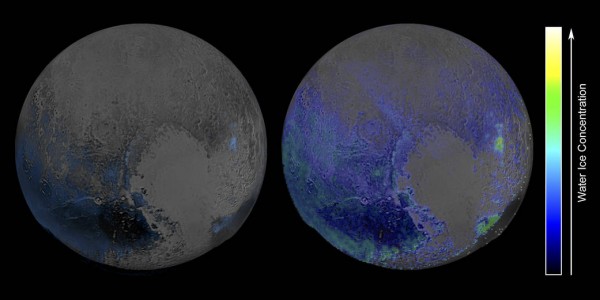By Ana Verayo, | January 31, 2016

This new map reveals more water ice spread out on the surface of Pluto.
New data taken from NASA's New Horizons spacecraft reveals how Pluto apparently possess more water on its surface than first thought.
A new image was released showing water ice features that are surprisingly abundant on the surface of the dwarf planet. This false color image was based on observations using infrared light taken by the probe's LEISA instrument (Ralph/Linear Etalon Imaging Spectral Array) from two separate scans of Pluto last July 2015, from a distance of 67,000 miles above its surface.
Like Us on Facebook
The scans were combined together to form a multispectral "data cube" of Pluto's entire hemisphere that was visible to New Horizons during its flyby last July 2015. The scans were each captured within a 15 minute interval, showing a three dimensional view of Pluto that is interpreted as a data cube using LEISA sensitive wavelengths for each side.
Pluto's crust is also made of water ice, which serves as a "bedrock" where volatile ices can determine the different changing seasonal patterns of the dwarf planet. Prior maps of ice water bedrock taken by New Horizons are compared with LEISA spectra data along with pure water ice template spectrum map helped create this latest water ice bedrock map.
This method is quite challenging as the water ice on Pluto can be covered by methane ice, which means that the map can only identify areas that are rich in water ice or has less methane reserves emanating from the surface.
Another method is utilized which can yield better and more accurate maps, that involves Pluto's entire various ices together in a single map. This technique can also become limiting as it only maps the ices that are only included in the model, where the New Horizons team is in the process of adding more data to improve this current model.
This new map reveals more exposed water ice that are apparently more widespread across Pluto's surface than first thought, which is a crucial finding. However, even if this map shows more volatile, spreading water ices, there are only a few or almost no traces of water in some regions such as the Sputnik Planum or more known as Pluto's "heart" and around the Lowell Regio which is up north of the hemisphere covered by the probe.
Scientists say that these regions can be considered as rich in methane, nitrogen and carbon monoxide that can form thick blankets of ice, hiding the water ice bedrock beneath it.
-
Use of Coronavirus Pandemic Drones Raises Privacy Concerns: Drones Spread Fear, Local Officials Say

-
Coronavirus Hampers The Delivery Of Lockheed Martin F-35 Stealth Fighters For 2020

-
Instagram Speeds Up Plans to Add Account Memorialization Feature Due to COVID-19 Deaths

-
NASA: Perseverance Plans to Bring 'Mars Rock' to Earth in 2031

-
600 Dead And 3,000 In The Hospital as Iranians Believed Drinking High-Concentrations of Alcohol Can Cure The Coronavirus

-
600 Dead And 3,000 In The Hospital as Iranians Believed Drinking High-Concentrations of Alcohol Can Cure The Coronavirus

-
COVID-19: Doctors, Nurses Use Virtual Reality to Learn New Skills in Treating Coronavirus Patients







